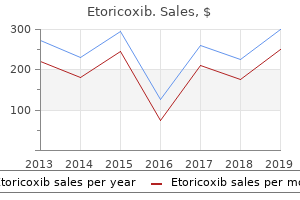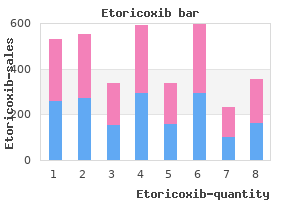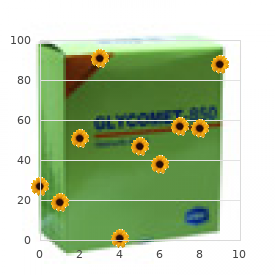Etoricoxib
"Generic 120 mg etoricoxib amex, arthritis diet food list".
By: G. Trano, M.A., M.D., Ph.D.
Clinical Director, Sam Houston State University College of Osteopathic Medicine

Hydrology for urban land planning: A guidebook on the hydrologic results of urban land use arthritis thumb surgery buy 90mg etoricoxib otc. The road to can arthritis in feet cause swelling buy discount etoricoxib 60 mg online extinction is paved with good intentions: Negative affiliation of fish hatcheries with threatened salmon arthritis in lower back discs purchase etoricoxib pills in toronto. Proceedings of the Royal Society-Biological Sciences (Series B) 268(1472):11531158. Effects of urban runoff from a detention pond on water quality, temperature and caged gammarus minus (say) (amphipoda) in a headwater stream. The limitations of mitigation-based stormwater administration within the pacific northwest and the potential of a conservation strategy based on low-influence development ideas. A comparison of channel erosion in small urban and rural catchments, Armidale, New South Wales. Effects of design practice for flood management and best administration practices on the move-frequency curve. Watershed Management for Potable Water Supply: Assessing the New York City Strategy. Quantity and quality of storm runoff from three urban catchments in Bellevue, Washington. Investigating hydrological alteration as a mechanism of fish assemblage shifts in urbanizing streams. Controlling Urban Runoff: A Practical Manual for Planning and Designing Urban Best Management Practices. Modification and evaluation of an index of biotic integrity to quantify stream quality in Southern Ontario. Water localisation and reclamation: Steps in direction of low influence urban design and development. Stream restoration in urban catchments via redesigning stormwater methods: Looking to the catchment to save the stream. Influences of watershed land use on habitat quality 1 and biotic integrity in Wisconsin streams. Impacts of urbanization on stream habitat and fish throughout a number of spatial scales. Effects of building on fluvial sediment, urban and suburban areas of Maryland. Perhaps because this longstanding environmental drawback is being addressed so late within the development and administration of urban watersheds, the legal guidelines that mandate better stormwater management are generally incomplete and were usually handed for other purposes, like industrial waste management. This chapter discusses the regulatory applications that govern stormwater, notably the federal program, explaining how these applications manage stormwater solely impartially and sometimes inadequately. While progress has been made within the regulation of urban stormwater-from the preliminary emphasis on simply moving it away from constructions and cities as quick as possible to its position in degrading neighboring waterbodies-a major variety of gaps stay within the existing system. Chapter 6 returns to these gaps and considers the ways that a minimum of some of them could also be addressed. Its lengthy-time period goal is the elimination of polluted discharges to surface waters (originally by 1985), although much of its present effort focuses on the interim goal of attaining swimmable and fishable waters. Initially enacted because the Federal Water Pollution Control Act in 1948, it was revised by amendments in 1972 that gave it a stronger regulatory, water chemistry-focused basis to deal with acute industrial and municipal effluents that existed within the Nineteen Seventies. Amendments in 1987 broadened its focus to deal with extra diffuse sources of impairments, including stormwater. The table reveals that whereas there was a flourish of regulatory activity associated to stormwater through the mid-1980s to 1990s, there was much much less regulatory activity since that point. A navigation-oriented statute that was used within the 1960s and Nineteen Seventies to 1886 problem unpermitted pollutant discharges from industry. Provided matching funds for wastewater remedy amenities, grants for state water pollution management applications, and restricted federal authority to act in opposition to interstate pollution. Required states to adopt water quality requirements for interstate waters subject to federal approval. As a result, enforceable requirements in opposition to polluting industries, even in interstate waters, was restricted. First rigorous national regulation prohibiting the discharge of pollutants into surface waters with no permit. Clean Water Act Section 208 Designated and funded the development of regional water quality administration plans to assess regional water quality, propose stream requirements, determine water quality drawback areas, and determine wastewater remedy plan lengthy-time period wants. These plans additionally embody coverage statements which give a typical constant basis for determination making.

Proof that crown gall was a illness attributable to a Agrobacterium-Taxonomy of Plant-Pathogenic Rhizobium Species 189 bacterial pathogen was made by Smith and Townsend (1907) arthritis medication off the market purchase cheap etoricoxib, who named the organism Bacterium tumefaciens with Chrysanthemum frutescens as host plant however suggesting a wider host range degenerative arthritis in lower back- exercises for order etoricoxib without prescription. This was one of many early demonstrations of bacterial pathogenicity to arthritis in fingers in 20s generic etoricoxib 60mg amex crops when that idea was still contentious. Agrobacterium vitis Ophel and Kerr 1990 Ophel and Kerr (1990) re-examined a sub-inhabitants of tumorigenic strains isolated from grape previously described as A. Agrobacterium larrymoorei Bouzar and Jones 2001 A tumorigenic pathogen isolated from aerial tumours in Ficus benjamina (Bouzar et al. For pathogens in Agrobacterium, as for pathogenic species in other genera, it was taken as a right that pathogenicity was the expression of significant and substantial phenotypic, and therefore genetic, differences, and that improved strategies would eventually maintain their characterization. This uncertainty was acknowledged to be the results of the small number of strains obtainable and comparatively few established discriminating examined (Allen and Holding, 1974). Allen and Holding (1974) maintained species nomenclature primarily based on pathogenicity and although they did notice the work of Keane et al. Realization that a high proportion (>ninety%) of species names of micro organism were synonyms or were illegitimate indicated the necessity for nomenclatural revision. The Approved Lists included solely species names acknowledged as legitimate the place there was a modern description and no less than one extant pressure which might be accepted as the sort, or name-bearing, pressure (Lapage et al. Little public consideration had been given to revision of Agrobacterium nomenclature and, in spite of a proposal by Keane et al. Subsequently, this behavior was proven to be derived from transfer of plasmids as conjugative components (Genetello et al. It is usually assumed that the genes for pathogenicity are plasmid-borne in all Agrobacterium spp. Recognition that tumorigenic or rhizogenic functionality was mediated by genes on transmissible plasmids carried by A. Furthermore, the small genetic and phenotypic contribution of plasmids to the phenotype and genotype of micro organism was believed to be insignificant in terms of differentiation of species. After Holmes and Roberts (1981); (2001) Bradbury (1986); Holmes (1988); Moore et al. Kersters and De Ley (1984) acknowledged the compelling evidence primarily based on the sooner studies for recognition of pure species of Agrobacterium. However, they acknowledged without clarification, and apparently without contemplating the potential of emendation of species descriptions, that acceptance of a classification primarily based on pure species would require a change of names of A. Kersters and De Ley (1984) therefore elected to follow the sooner nomenclature primarily based on pathogenicity (Allen and Holding, 1974). Classification and nomenclature of pure Agrobacterium species is (Table 5-1): 1. Agrobacterium radiobacter as described by Holmes and Roberts (1981) includes the sort strains of oncogenic A. Agrobacterium rubi is characterized in genotypic and phenotypic terms and is normally isolated from above-ground cane galls of Rubus spp. Agrobacterium vitis Ophel and Kerr (1990) was proposed because the name for biotype 3 of Keane et al. Following the report of Holmes and Roberts (1981) of a pure classification for Agrobacterium spp. The names may be used both in a pure classification (Bradbury, 1986; Moore et al. However, the truth that pathogenicity genes are carried on plasmids implies that the pathogenic character of any pressure is unstable. This lack of stability would make uncertain the appliance of pathovar names to explicit strains, most notably to pathotype strains. For pathogenic agrobacterial strains, therefore, formal pathovar nomenclature appears inappropriate. Without clarification, Pribram (1933) proposed the mixture Rhizobium radiobacter, anticipating the debate regarding the frequent generic relationship of Agrobacterium spp. The solely systematic difference recorded between the genera has been their oncogenic (Agrobacterium) or symbiotic (Rhizobium) interactions with crops.
However arthritis at 20 order etoricoxib 90mg with visa, the depth of sequencing that might be required to rheumatoid arthritis zandu generic etoricoxib 90 mg without a prescription certify the absence of off-target cutting is at present tough to zen arthritis spray trusted 60mg etoricoxib obtain for populations of cells. It should be possible, nonetheless, to estimate the sensitivity of the system for detecting off-target editing. Failure to detect editing with the assay would then indicate that the off-target editing price was under the detection level. Digenome-seq thus could detect potential further off-target cleavage at websites that might otherwise be obscured in cell-based methods. However, issues in regards to the potential risk of unwanted off-target effects have dominated many current discussions. Most experiments which have detected significant off-targets have been performed in most cancers cells (Fu et al. Nevertheless, will probably be important to determine whether there are specific cell-types and circumstances that predispose for the buildup of off-target events. To address issues about off-target events, diverse approaches to reduce mistargeting are being developed. This brief sequence is used for tag-specific amplification adopted by excessive-throughput sequencing to establish off-target cleavage websites. Off-target cleavage websites (prey) are identified by evaluation of those translocation junctions. Adapter-ligated fragments are enriched and amplified for highthroughput sequencing. Sequencing adapters are ligated and excessive-throughput sequencing is performed at standard whole-genome sequencing coverage. Remarkably this enhanced the specificity of Cas9 cutting with out obviously impairing its total efficiency. Based on this function, there are two ways of inactivating Cas9: single inactivation and double inactivation (Guilinger et al. In a second strategy, each cleavage websites of Cas9 are inactivated, yielding nuclease-deficient "useless" Cas9 (dCas9), which is then fused to the FokI cleavage domain. Because of those stringent necessities, the off-target price is greatly decreased, albeit with elevated problem in target selection. These methods have been shown to significantly scale back off-target charges (Guilinger et al. Moving forward will probably be important to develop alternate base-editors capable of mediating a wider range of genetic modifications ideally ultimately allowing conversion of any base to another base inside a userdefined window. As a medical product or medical practice, genome editing should be safe, efficacious, and price-efficient. Although the specifics could range from case to case, the general principle of monitoring to guarantee security and efficacy should be carried out. In distinction, it will be quite tough to monitor embryos in the event that they had been to bear editing. Functional equivalence assays must be developed and agreed upon to function high quality control measures. Alternatives may be thought of, similar to editing performed on sperm progenitor cells. It is probably going that most if not all such epigenetic modifications would fail to be handed to subsequent generations thus alleviating a number of the issues surrounding germline-editing approaches. By the identical token, the transient nature of those modifications limits their utility for correcting ailments brought on by genetic mutations. Possible makes use of for such transient germline engineering, nonetheless, include the ability to expand germ cells, or the in vitro generation of desired stem cells or terminally differentiated cells. Additionally, the transient nature of the modifications might expand the number of genes that could possibly be safely targeted. Because no everlasting, heritable modifications are made to the person, the usage of dCas9 to alter gene expression does alleviate some moral issues. Nonetheless, at present the potential makes use of of dCas9 on embryos appear rather restricted compared to approaches involving germline editing, and the extra instant therapeutic functions of dCas9 probably involve somatic alteration in gene expression. One powerful expertise is based on manipulating mouse embryos in vitro and transferring the embryos to a foster mom to produce genetically altered animals (see Figure A-6). The collagen I gene was the first endogenous gene inactivated by retroviral insertional mutagenesis leading to mutant mice whose phenotype resembled brittle bone disease (Schnieke et al.

